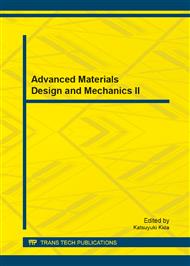p.450
p.454
p.459
p.463
p.467
p.471
p.478
p.486
p.491
Design and Analysis of Compliant Rotary Joint
Abstract:
Unlike rigid-body mechanisms, compliant mechanisms (CMs) gain some or all of their motion from relative flexibility of their joints. This paper presents a pseudo-rigid-body model (PRBM) method and virtual work to design and analyze kinematics and dynamics for compliant rotary joints or flexure hinges in the processing of compliant mechanisms. The stress at flexible pivot, the nonlinear-large deflection of flexure hinge, the relationship between displacement and force and/or torque, stress were taken into account in this work based on PRBM. A numerical software package, ANSYS, was exploited to illustrate schematic diagram of the stress versus to horizontal displacement of free end AB of flexure hinge. A mechanism with the desired structure is that one of the most popular aspects, which is needed to take into account in the design phase in advance. The results revealed that the proposed effective approach can be further easily applied in compliant mechanism structures. Future work will focus on multi-objective structural optimization of the flexure hinge.
Info:
Periodical:
Pages:
467-470
Citation:
Online since:
August 2013
Authors:
Price:
Сopyright:
© 2013 Trans Tech Publications Ltd. All Rights Reserved
Share:
Citation:


